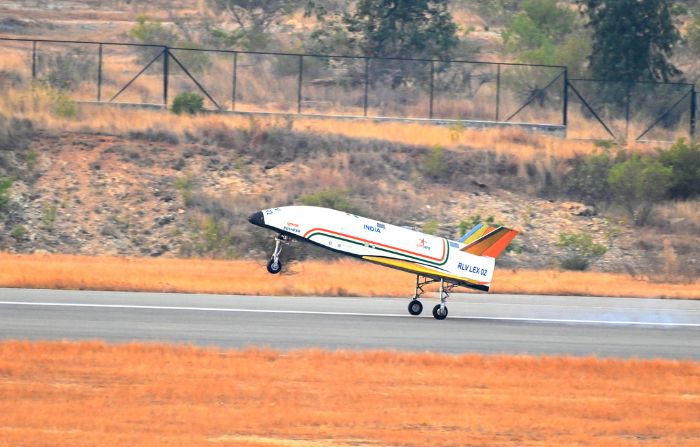- Sunday, April 20, 2025
Through the launch of ‘Pushpak’, India makes an attempt towards a more affordable and sustainable access to space.

By: Shubham Ghosh
INDIA’S space agency ISRO (Indian Space Research Organisation) on Friday (22) successfully conducted the landing mission of ‘Pushpak’ — its Reusable Launch Vehicle (RLV) from the Aeronautical Test Range in Challakere in the southern state of Karnataka. The facility is used for integrating and testing various unmanned air vehicles before inducting into the armed forces and other organisations.
S Somanath, chairman of ISRO, was present at the launch site along with other senior officials.
ISRO later posted about the event on X saying, “Isro nails it again! Pushpak (RLV-TD), the winged vehicle, landed autonomously with precision on the runway after being released from an off-nominal position.”
Read: India’s first solar mission spacecraft Aditya-L1 gets send off from Earth: ISRO
Through the launch of ‘Pushpak’, India makes an attempt towards a more affordable and sustainable access to space.
Pushpak captured during its autonomous landing? pic.twitter.com/zx9JqbeslX
— ISRO (@isro) March 22, 2024
The launch of Pushpak is India’s bold attempt towards making access to space more affordable and sustainable.
Read: Modi reaches Bengaluru from Greece to meet ISRO scientists after Chandrayaan-3 success
The agency also said that ‘Pushpak’ was lifted by an Indian Air Force’s Chinook helicopter and released from an altitude of more than four kilometres. After being released at a distance of four kilometres from the runway, the RLV “autonomously approached the runway along with cross-range connections” and “landed precisely on the runway and came to a halt using its brake parachute, landing gear brakes and nose wheel steering system”, ISRO added.
‘Pushpak’ is designed as an all-rocket which is a fully reusable single-stage-to-orbit vehicle with major features such as X-33 advanced technology demonstrator, X-34 testbed technology demonstrator and the upgraded DC-XA flight demonstrator.
The latest launch marked the vehicle’s third flight. Previously, it underwent a series of tests to make its robotic landing capabilities precise under challenging conditions.
Named after the mythical ‘Pushpak Viman’ from Hindu epic Ramayana, the modern-day aircraft is a symbol of innovation and prosperity.
The project has been in development for more than a decade. It saw a successful test in April 2023, where the vehicle did an autonomous landing after being released from a Chinook helicopter.
The project has seen an investment exceeding Rs 100 crore and showcases India’s technological prowess. It also sets the stage for future goals, including establishing the Bhartiya Antariksha Station or India’s own space station, by 2035.
Prime minister Narendra Modi was briefed about the development of the ‘Pushpak’ project by Somanath during his visit to Vikram Sarabhai Space Centre in the southern state of Kerala last month.